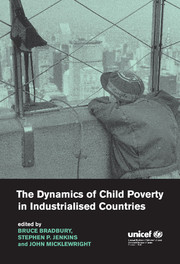Book contents
- Frontmatter
- Contents
- List of figures
- List of tables
- Notes on the contributors
- Acknowledgements
- 1 Beyond the snapshot: a dynamic view of child poverty
- Part I Issues and cross-national evidence
- Part II Topics in child poverty dynamics
- Summary and policy conclusions
- 12 Thinking about children in time
- Index of authors
- Index by subject
12 - Thinking about children in time
Published online by Cambridge University Press: 02 December 2009
- Frontmatter
- Contents
- List of figures
- List of tables
- Notes on the contributors
- Acknowledgements
- 1 Beyond the snapshot: a dynamic view of child poverty
- Part I Issues and cross-national evidence
- Part II Topics in child poverty dynamics
- Summary and policy conclusions
- 12 Thinking about children in time
- Index of authors
- Index by subject
Summary
What have we learned from this book?
The papers collected in this book demonstrate the power, the promise and some of the current limits of examining the dynamics of child poverty. They reveal both striking consistencies and sharp differences across countries in the depth and persistence of economic distress among families rearing children. They illustrate which families seem to struggle the most. They help us understand when high poverty is offset by high mobility and the situations where it is not. And they point to the causes of more serious, longer-term poverty. In doing so these papers also help to chart a course for the future of research on policy, offering the reader both challenges and opportunities.
In this concluding chapter we seek first to summarise what was learned about child poverty; second, to identify limits to the current research and suggest elements of a future research agenda; and, third, to draw on the research in order to reflect on policy directions stimulated by research on dynamics. Throughout, we endeavour to illustrate how thinking about child poverty in time may help us to identify solutions to child poverty in time.
Dynamic analysis steps beyond the static world of counting how many are poor in a host of exciting and important ways. Until recently, discussions of poverty focused primarily on the question of who is poor at any one time. The answer was derived typically by comparing annual income to a poverty standard.
- Type
- Chapter
- Information
- The Dynamics of Child Poverty in Industrialised Countries , pp. 281 - 300Publisher: Cambridge University PressPrint publication year: 2001
- 4
- Cited by

